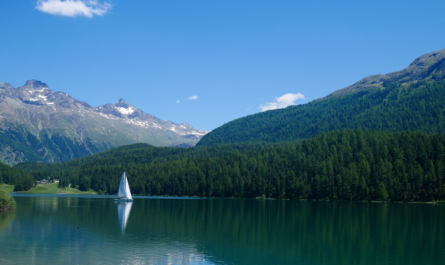Nestled in Switzerland’s Engadin Valley, Saint Moritz is a name synonymous with winter sports glamour, Olympic history, and jet-set extravagance. Yet, long before it became a playground for the elite, this alpine town owed its fame to a far quieter force: its mineral springs. For over three millennia, these iron-rich waters have drawn travelers seeking healing, spiritual renewal, and communion with nature. The story of Saint Moritz is not just one of snow-capped peaks and champagne parties—it is a saga of how mineral springs transformed a remote mountain village into a global icon of wellness and luxury.
Ancient Origins: Bronze Age Rituals and Roman Reverence
The history of Saint Moritz’s mineral springs begins in the shadows of prehistory. Archaeological excavations near the town have uncovered Bronze Age artifacts (circa 1800 BCE) clustered around the springs, suggesting early inhabitants recognized their therapeutic value. The Celts, who inhabited the Alps from 450 BCE, revered natural springs as gateways to the divine, often dedicating them to deities of healing and fertility.
The Romans, masters of hydrotherapy, further elevated the springs’ status. Though they never established a permanent settlement in the high Engadin, Roman soldiers and traders traversing the Alpine passes likely used the springs to treat battle wounds and fatigue. Local legend attributes the discovery of the springs to Saint Mauritius (Moritz in German), a Roman legionary and Christian martyr whose followers sought refuge in the Alps during the 3rd century CE. According to lore, Mauritius’s troops drank from the springs during their campaigns, cementing their association with vitality and resilience.
By the Middle Ages, the springs had become a pilgrimage site. Monks from nearby monasteries documented their use for treating ailments like arthritis, skin diseases, and “melancholia” (depression). The water’s distinctive reddish hue—caused by dissolved iron oxide—earned it the nickname “aqua sanguinis” (blood water), and pilgrims believed it carried the blessing of Saint Mauritius himself.
The Renaissance: Paracelsus and the Birth of Medical Tourism
The 16th century marked a turning point for Saint Moritz’s springs, thanks to the Swiss physician and alchemist Paracelsus (1493–1541). A pioneer of early modern medicine, Paracelsus traveled extensively through the Alps, studying mineral waters and their effects on the human body. In his treatise “Von den natürlichen Bädern” (On Natural Baths), he hailed the Saint Moritz springs as “the blood of the earth, rich in the spirit of iron, which fortifies the humors and restores balance to the soul.”
Paracelsus’s endorsement transformed the springs from a local curiosity into a regional attraction. By the late 1500s, rudimentary bathhouses had been constructed around the main springs, offering wooden tubs for soaking and stone troughs for drinking cures. Wealthy patrons from the Swiss Confederation and northern Italy began undertaking the arduous journey to the Engadin, often spending weeks at the springs to treat ailments ranging from gout to digestive disorders.
The 17th and 18th centuries saw the rise of “water doctors”—itinerant physicians who prescribed personalized regimens of bathing, drinking, and diet. These protocols, though rooted in the outdated humoral theory of medicine, drew on the springs’ iron content, which we now know can aid in treating anemia and fatigue. Visitors would drink up to a liter of the metallic-tasting water daily, followed by vigorous walks in the mountain air to “activate the humors.”
The 19th Century: Spa Mania and the Birth of Alpine Elegance
The 19th century was the golden age of European spa culture, and Saint Moritz rode the wave. Three key developments propelled its rise:
- Medical Endorsements: By the 1820s, prominent physicians like Dr. Johann Jakob Guggenbühl published studies linking the springs to improved outcomes for tuberculosis patients. The dry, sunny climate of the Upper Engadin—dubbed “champagne air”—was hailed as a remedy for “consumptive” urbanites.
- Infrastructure: The 1832 opening of Badehaus St. Moritz, the town’s first dedicated spa facility, offered private baths, steam rooms, and a grand hall for socializing. Guests could now enjoy hydrotherapy without roughing it in rustic lodgings.
- Rail Access: The completion of the Albula Railway in 1903 connected Saint Moritz to Zurich, Milan, and Vienna, slashing travel time from days to hours.
The clientele shifted from regional nobility to an international elite. Composers like Richard Wagner and Franz Liszt retreated to Saint Moritz to escape creative blocks, while writers such as Thomas Mann and Henrik Ibsen found inspiration in the stark beauty of the Engadin. The springs also attracted European royalty, including Queen Victoria’s son Leopold, Duke of Albany, who visited in 1882 to treat his hemophilia.
The iconic Heiligkreuz (Holy Cross) spring became the town’s symbol. Encased in a Gothic Revival pavilion, its iron-red waters were piped directly into hotel baths. Guests adhered to strict schedules:
- 7 AM: Cold mineral water soak to “invigorate the nerves.”
- 10 AM: Guided mountain hike to “oxygenate the blood.”
- 4 PM: Social tea in the spa lounge, often accompanied by chamber music.
Johannes Badrutt and the Invention of Winter Tourism
In 1864, Saint Moritz’s fate took a dramatic turn thanks to Johannes Badrutt, owner of the Pension Faller (later the Kulm Hotel). Legend has it that Badrutt wagered with his British summer guests: if they returned in winter and disliked the experience, he would cover their travel costs. Intrigued, a handful accepted—and were enchanted by the sun-drenched winters, where daytime temperatures often rose above freezing despite the snow.
Badrutt’s gamble birthed winter tourism in the Alps. By the 1880s, Saint Moritz was a dual-season destination:
- Summer: Spa-goers soaked in mineral baths and hiked flower-strewn trails.
- Winter: The wealthy elite skied, ice-skated, and attended glamorous balls.
The springs remained central to the town’s identity. Badrutt’s Palace Hotel (opened 1896) featured a state-of-the-art thermal spa, where guests alternated between steam rooms and ice plunges—a practice believed to boost circulation.
Belle Époque Opulence: Marble Baths and Modernist Icons
The Belle Époque (1871–1914) cemented Saint Moritz’s reputation as Europe’s most exclusive spa retreat. Grand hotels like the Carlton, Suvretta House, and Kulm competed to offer the most lavish spa experiences:
- Roman-Inspired Thermal Halls: Marble columns, mosaic floors, and stained-glass windows adorned spa wings.
- Electrotherapy: A novelty in the 1890s, guests received mild electric currents in mineral water baths to “stimulate vitality.”
- Mountain Air Cures: Doctors prescribed sunrise strolls to absorb the Engadin’s “ozone-rich” air, believed to purify the lungs.
The Quellenhaus (Spring House), built in 1933 over the Heiligkreuz spring, became a modernist masterpiece. Designed by architect Nicolaus Hartmann Jr., its clean lines and glass walls contrasted with the ornate hotels, symbolizing Saint Moritz’s blend of tradition and innovation.
World Wars to Wellness Revival: Adapting to a New Era
The World Wars disrupted Europe’s spa culture. Post-1945, Saint Moritz pivoted to winter sports, hosting the 1948 Winter Olympics and courting a younger, sportier crowd. The springs faded into the background—many historic bathhouses were demolished or converted into ski lodges.
The 1970s wellness revival reignited interest. New spas like Ovaverva (Kempinski Grand Hotel) and Hauser Spa (Badrutt’s Palace) fused ancient springs with modern therapies:
- Thalassotherapy: Seaweed wraps using mineral water.
- Ayurveda: Herbal treatments tailored to the Alpine environment.
- Cryotherapy: Ice chambers inspired by traditional ice baths.
The 21st Century: Sustainability and Cultural Legacy
Today, Saint Moritz balances luxury with environmental stewardship. The original Heiligkreuz spring still flows at the Quellenhaus, where visitors taste its effervescent, iron-rich water—a ritual unchanged for centuries. The town’s coat of arms, depicting Saint Mauritius holding a spring, underscores this heritage.
Key initiatives include:
- Carbon-Neutral Spas: Hotels like Villa Flor use geothermal energy to heat mineral baths.
- Water Conservation: Strict quotas protect the springs from overuse.
- Cultural Events: The St. Moritz Gourmet Festival pairs mineral water with haute cuisine, while the White Turf horse races incorporate wellness pop-ups.
Conclusion: The Eternal Springs
From Bronze Age rituals to Instagrammable spa retreats, Saint Moritz’s mineral springs have been a constant amid relentless reinvention. They remind us that before the ski lifts and champagne toasts, this alpine utopia was built on the belief that nature holds the power to heal. As climate change threatens Alpine ecosystems, Saint Moritz’s commitment to sustainability ensures its springs will continue to inspire—a liquid thread connecting past, present, and future.
The mineral springs of Saint Moritz are more than natural wonders—they are symbols of humanity’s enduring quest for renewal. For thousands of years, people have journeyed to these waters seeking physical healing, mental clarity, and spiritual solace. Today, as visitors sip from the Heiligkreuz spring or unwind in a geothermal pool, they participate in a ritual as ancient as the Alps themselves. Saint Moritz’s story teaches us that true luxury is not just opulence but the ability to reconnect with nature’s rhythms, a lesson as vital now as it was to Bronze Age pilgrims.
Saint Moritz’s springs have witnessed empires rise and fall, wars ravage continents, and societies redefine progress. Yet they remain unchanged, a silent bridge between epochs. The Roman soldier, the Romantic poet, the modern skier—all have found something essential in these waters. This continuity reminds us that while technologies and trends evolve, our fundamental need for connection—to nature, to history, to one another—remains constant. In a fragmented world, Saint Moritz stands as a rare thread weaving together disparate eras and identities.
The evolution of Saint Moritz’s springs mirrors the paradox of modernity: the more we advance, the more we yearn for the primal. The same society that built bullet trains and cryotherapy chambers still flocks to drink iron-rich water from a Bronze Age spring. Saint Moritz’s success lies in harmonizing these contrasts, offering cutting-edge wellness without erasing the raw, elemental power of its origins. It challenges us to ask: Can progress honor the past while innovating for the future? The town’s answer, written in steam and stone, is a resounding yes.



